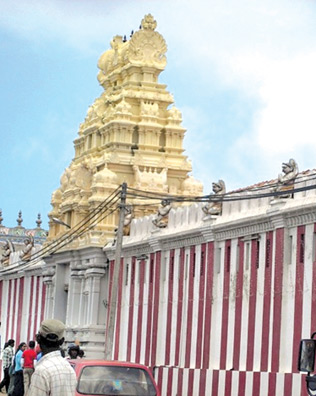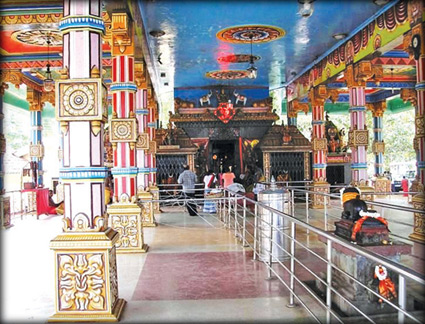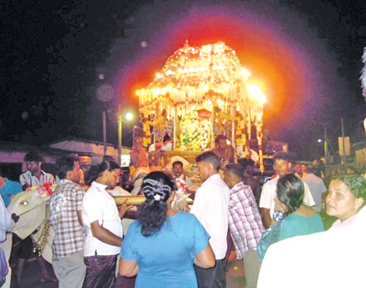|

Shri Munnesweram Ishwara Maha Devale, Chilaw |
Shri Munnesweram Ishwara Maha Devale :
Month-long Nikini Maha Festival
Text and pix by Christie Fernando - Chilaw special
cor.
With peace pervading in the country, an influx of devotees from all
walks of life is anticipated and Hindus in large numbers will converge
on the outskirts of the ancient and legendary Shri Munneswaram Ishwara
Maha Devale two miles off Chilaw for the month-long Hindu festival.
Pilgrims from India too make a beeline to the temple to seek favours
and blessings from the deities.
Unlike the previous years, unprecedented crowds are expected during
the festive season and precautions are taken to prevent a stamped and
maintain smooth movement of crowds, especially before the final week of
the festival and during processions when taking the Grand Chariot in
procession.
The police patrol the area day and night to curb any unruly behaviour
and hooliganism. Police will ensure prevention of pick-pocketing and
harassment to devotees right round the clock.
Shri Munneswaram Devasthanams Chief priest and Trustee S. Padmanaban
Kurukkal said many fancy stalls and eating-houses leased out for the
festive month of celebrations are cited away from the main temple.
As in the days of yore, the carnival atmosphere will prevail for
visitors to Chilaw during the festive season with a variety of shows,
open-air theatre and entertainment and regale the visitors.
Vendors exhibit their merchandise and wares of all types by the
roadside right from Chilaw town to the surrounding area of the temple
premises.
The young and old revel the glittering colours and the vivacious
extravaganza. This busy thoroughfare is restricted to either side of the
road, leading to the temple.
The hurly-burly atmosphere for amusement and enjoyment of youths and
kids are galore.
|

Thiru Adi Kali temple dedicated to goddess Kali situated in
close proximity to Shri Munnesweram temple, Chilaw |
The merry-go-round and other forms of entertainment opened to the
public attract the youth though it detracts the religious fervour of the
festival. The gala atmosphere prevails to perpetuate the spirit of the
festival.
Processions are held daily inside and outside the temple. Kavadi
dancing and pageantry according to Hindu custom and practice are part of
the festival and merriment.
The devotees invoke divine blessings in a spirit of supplication and
penance for their past lapses and transgressions.
Rituals
The rituals performed at the Munnesweram Kovil are unique and
unparalleled compared to other ritualistic ceremonies performed in
well-known temples in the island, in that, the devotees are seen keeping
vigil in the precincts of the temple, engrossed in prayer and
contemplation and remorse for their sins and omissions. Some penitents
are seen lying prostrate or walking about with their flesh pierced with
spikes and darts with ash sprinkled on their foreheads in penitence and
atonement.
Offerings of devotees are placed in front of the deities by the
officiating Hindu priests inside the inner sanctum. Another conspicuous
hallmark of the gifts offered by devotees is the dashing of coconuts in
the periphery of the temple. The priests also chant incantations to the
deities on behalf of Hindu and other adherents present.
Reminiscing the legend connected with this festival, the Munnesweram
Hindu Shrine is regarded as one of the oldest Hindu temples in the
island. It has a strange origin according to the legend.
Rama after slaying Ravana was returning to India with Sita in his
“Air Chariot”, when impulsively a desperate feeling of guilt gripped
him. It is also said that when passing Munneswaram in his air chariot,
he espied a spire of the temple and decided to alight and worship there,
and while praying, Lord Siva and His consort Parvathy appeared before
him and feeling the compassion for the penitent Rama, ordered him to
enshrine three Sivalingams, one in each of the most sacred places namely
Muuneswaram, Koneswaram and Thiruketheeswaram.
Lord Siva, according to legend, had pointed to a place north of the
Mayavan Aru (Mee Oya) and told him to enshrine the relic. Rama built the
temple at the exact spot, which is now known as Munneswaram.
The festival is shrouded in antiquity. According to legend, one
full-moon night, in the month of Nikini, a sage who was meditating under
a banyan tree looked up and saw goddess Amman, the mother of Skanda, who
readily granted him his wishes.
He had asked her to bless all the pilgrims assembled there for
worship, and ever afterwards, a great festival is held in memory of the
meeting of Agastiar, the sage and Amman, and is continued to this day.
|

The Grand Chariot (Ther) taken in procession |
Only a stone’s throw away from the main temple is Thiru Adi Kali
temple dedicated to goddess Kali. Devotees who make vows to goddess Kali
were known to show results instantly. For, she is believed to punish the
wrongdoers; lost articles are found through her intercession. Devotees
also visit this temple seeking favours from her.
The festival culminates in a fitting finale with pomp and pageantry
with the Water-cutting Ceremony at Deduru Oya two miles off Chilaw on
Binara full moon Poya day, Monday, September 8 at 12 noon.
Other rituals and festivities continue till September 10.
Celebration
The festival which beging with the flag-hoisting ceremony, is a hive
of activity for over 30 days. It comes to a close on September 10 with
the festive celebration.
The traditional Grand Chariot procession wends its way to the Deduru
Oya two miles away for ritual cleansing.
The devotees bathe in the river and in the evening, the Grand Chariot
carrying the deities passes through the Chilaw town and stops in front
of the Chilaw Urban Council, where to the beating of drums, sounding of
trumpets and gleeful Kavadi dancing and rejoicing continue unabated for
about one hour.
The chariot then proceeds to the promenade of the Chilaw beach where
more festivities and rituals continue exuberantly before returning to
the temple at Munneswaram in the wee hours of the morning.
The Munneswaram hamlet then returns to its customary slumber - to
wake up expectantly the following year.

|

